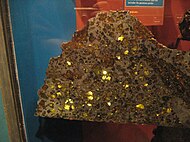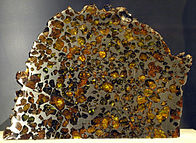
Esquel (meteorite)
| Esquel | |
|---|---|
 The slice shows the crystals' transparency | |
| Type | Stony–iron |
| Class | Pallasite |
| Group | Main Group Pallasite (MGP) |
| Composition | 8.5% Ni, 21.5 ppm Ga, 55.5 ppm Ge, 0.023 ppm Ir |
| Country | Argentina |
| Region | Esquel, Chubut |
| Coordinates | 42°54′S 71°20′W / 42.900°S 71.333°W |
| Observed fall | No |
| Found date | 1951[1] |
| TKW | 755 kg[2] |
Esquel is a meteorite found near Esquel, a Patagonian town in the northwest part of the province of Chubut in Argentina. It is a pallasite, a type of stony–iron meteorite that when cut and polished shows yellowish olivine (peridot) crystals.

In 1951 a farmer uncovered a meteorite in an unknown location near Esquel while digging a hole for a water tank. The meteorite was purchased from the finders and taken to the United States in 1992 by meteorite expert Robert Haag. The Esquel pallasite is known worldwide among collectors and the meteoritical scientific community. Esquel is regarded as one of the most beautiful meteorites ever found and is also one of the most desirable pallasites among meteorite collectors. It is a main group pallasite (MGP).

Specimens

The Meteoritical Bulletin no. 29 (1964) reports a main mass of "about 1500 kg".[1] However O. A. Turone claimed a main mass weight of 755 kilograms (1,664 lb).[3] Robert Haag, the buyer of the main mass, reported a weight of 680 kilograms (1,500 lb).[4] Almost all of the Esquel ever found on the market is cut from his piece.

Notes and references
- ^ a b Meteoritical Bulletin, no. 29, Moscow (1964)
- ^ Meteoritical Bulletin Database: Esquel
- ^ "The weight of the main mass is 755kg and not 1500kg as indicated", O.A.Turone, Buenos Aires, priv. comm. to J.Koblitz, 1994. MetBase 7.0 for Windows. Author: Joern Koblitz, The MetBase Library of Meteoritics and Planetary Sciences, Benquestrasse 27, D-28209 Bremen, Germany
- ^ Ulff-Møller, Finn; Choi, Byeon-Gak; Rubin, Alan E.; Tran, Jacquelyn; Wasson, John T. (1998). "Paucity of sulfide in a large slab of Esquel: New perspectives on pallasite formation". Meteoritics & Planetary Science. 33 (2): 221. Bibcode:1998M&PS...33..221U. doi:10.1111/j.1945-5100.1998.tb01627.x.
See also
External links
- "Jewels from space:Esquel". American Museum of Natural History.
- "Image of the main mass left". Robert Haag website. Archived from the original on 2014-11-13.
- BBC article on the Esquel meteorite
- Meteoritical Bulletin Database: Esquel
See what we do next...
OR
By submitting your email or phone number, you're giving mschf permission to send you email and/or recurring marketing texts. Data rates may apply. Text stop to cancel, help for help.
Success: You're subscribed now !



